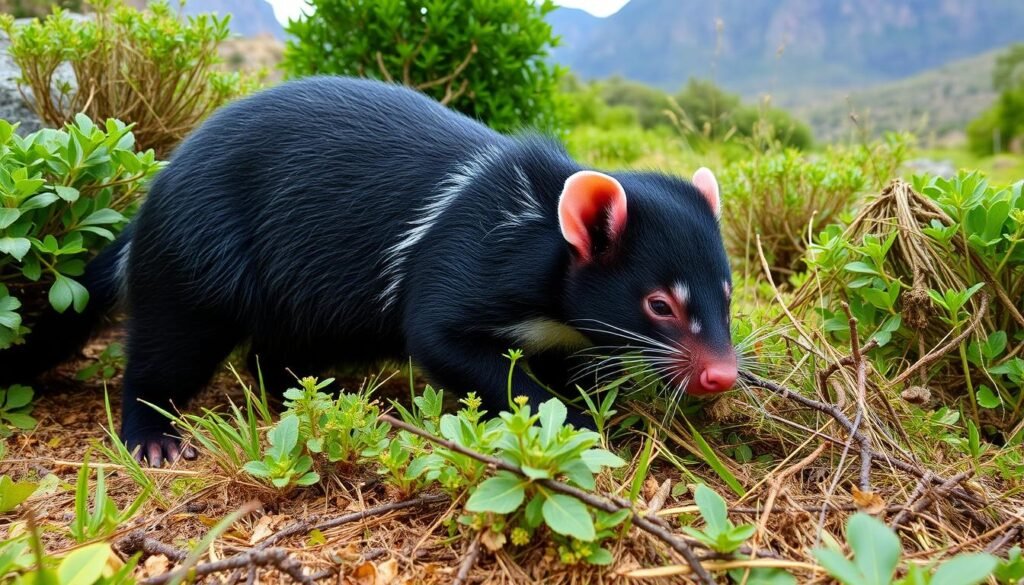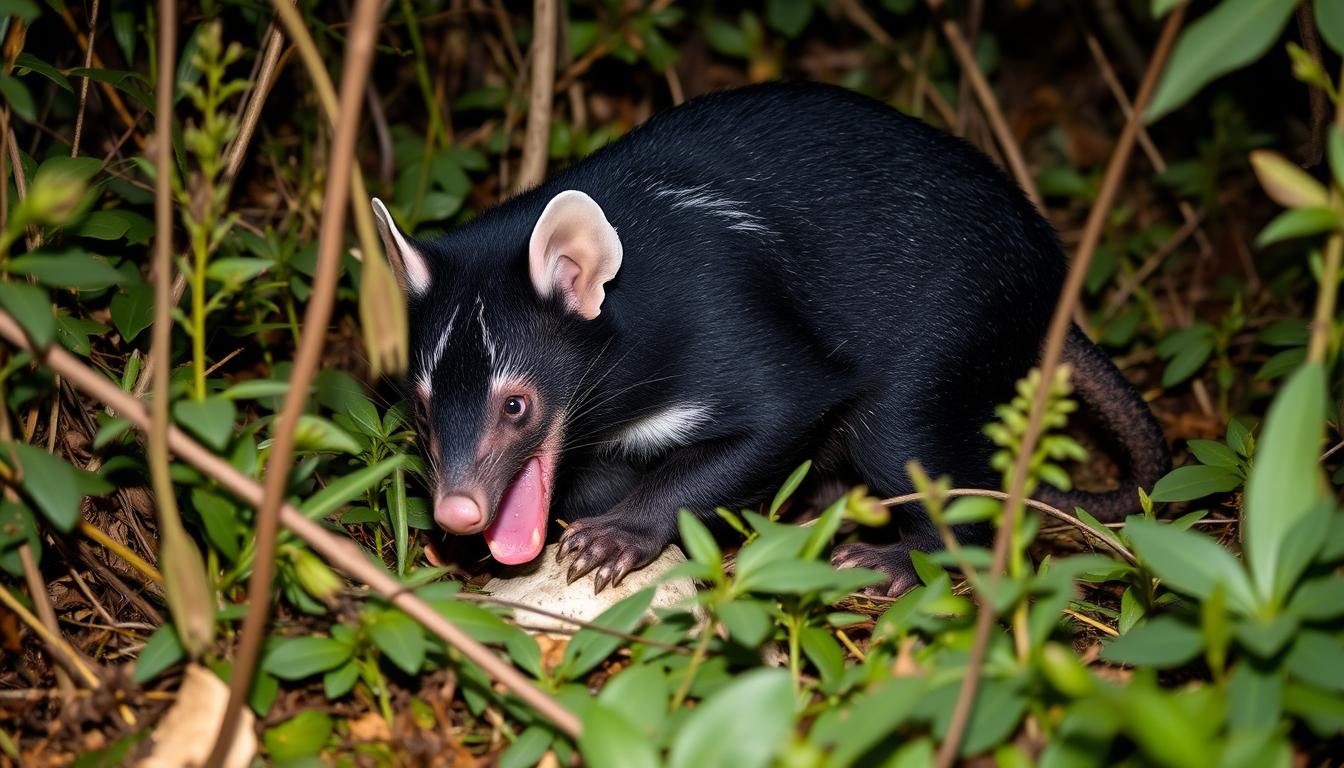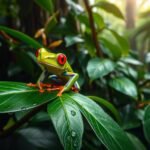In Tasmania, an island in Australia, lives a fascinating creature called the Tasmanian devil. It’s the biggest meat-eating mammal in the world. People from everywhere are drawn to its unique look and how it acts.
The Tasmanian devil is known for its strong jaws and skill at finding food. It’s a key part of Tasmania’s nature, helping keep the food chain balanced. Scientists and nature lovers are always interested in learning more about it.
Key Takeaways
- The Tasmanian devil is the world’s largest carnivorous marsupial, native to the island state of Tasmania, Australia.
- Known for its powerful jaws, scavenging abilities, and unique hunting techniques, the Tasmanian devil is a formidable predator in its ecosystem.
- Tasmanian devils play a crucial role in the balance of the local food web, feeding on a variety of prey and carrion.
- Conservation efforts are underway to protect the Tasmanian devil population, which has faced threats from habitat loss and the devastating impact of the Devil Facial Tumour Disease.
- Understanding the Tasmanian devil’s diet, behavior, and ecological significance is essential for its long-term survival and the preservation of Tasmania’s natural heritage.
Introduction to the Tasmanian Devil: The World’s Largest Carnivorous Marsupial
The Tasmanian devil, known as Sarcophilus harrisii, is the biggest carnivorous marsupial. It’s a strong, black creature, as big as a small dog. Its jaws and teeth are sharp, letting it hunt prey bigger than itself.
Physical Characteristics and Size
The Tasmanian devil is big and muscular. It has a large head and a short, thick neck. Its fur is black, sometimes with white on its chest or rump. It’s known for its loud growls and screeches.
Adult Tasmanian devils can be up to 30 inches long and weigh 12 to 26 pounds. They are the biggest carnivorous marsupials in the world.
Native Habitat and Distribution
The Tasmanian devil lives in Tasmania, an island off Australia’s southern coast. They like different places, like forests, grasslands, and mountains. They mostly live in the wild, only in Tasmania.
Conservation Status Overview
The Tasmanian devil is listed as Endangered on the IUCN Red List. A deadly facial cancer, Devil Facial Tumour Disease (DFTD), is a big threat. Efforts are being made to save this amazing creature from dying out.
“The Tasmanian devil is a true marvel of nature, a formidable predator that has captured the imagination of people around the world.”
Tasmanian Devil Diet and Behavior in the Wild
The Tasmanian devil is known for its loud growls and fierce behavior. It’s a fascinating carnivorous marsupial found in the wild. These nocturnal scavengers are key to the Tasmanian ecosystem. They eat carrion and small animals, keeping the balance.
With an amazing sense of smell, Tasmanian devils find their next meal easily. Whether it’s dead animal remains or live prey, they can find it. Their strong jaws and sharp teeth let them tear through tough skin and crush bones. This way, they get every bit of nutrition from their carnivorous diet.
| Diet Composition | Percentage |
|---|---|
| Carrion | 70% |
| Small Mammals | 20% |
| Birds and Reptiles | 10% |
Tasmanian devils are solitary animals. They fiercely defend their territories and resources. This aggressive nature also shows in their feeding habits. They compete with other devils and scavengers to get their share of a carcass.
“Tasmanian devils are remarkable animals, capable of consuming almost every part of their prey, from the bones to the fur. Their efficient feeding habits make them essential scavengers in their native habitat.”
Understanding Tasmanian devils’ diet and behavior helps us see their importance in the Tasmanian ecosystem. They play a vital role in keeping the balance.
Hunting Techniques and Feeding Habits
Tasmanian devils are known for their amazing hunting skills. They are opportunistic scavengers, great at finding and eating carcasses. They can strip bones and fur from their prey. Their strong jaws and sharp teeth let them eat live prey in just minutes, leaving nothing behind.
Scavenging Behavior
Tasmanian devils are famous for their nosy scavenging habits. They have a great sense of smell, helping them find food before others. When they find a meal, they defend it fiercely, growling and snapping at others.
Prey Selection
- Tasmanian devils mainly hunt small to medium-sized animals like possums, wallabies, and rabbits.
- They also eat the remains of bigger animals, including deer, wombats, and even dead Tasmanian devils.
- Their varied diet helps them survive in different places, ensuring they always have food.
Feeding Patterns
Tasmanian devils are known for their efficient feeding habits. They can eat a whole carcass, including bones and fur, in just minutes. This way, they make the most of their food, wasting little and getting lots of energy.
“Tasmanian devils are true masters of their environment, thriving as both predators and scavengers in the rugged Tasmanian landscape.”
Anatomical Adaptations for Hunting
The Tasmanian devil is a formidable hunter. Its muscular jaws and sharp teeth are key to its success. These features have evolved over time, making it a top predator and scavenger.
One of the Tasmanian devil’s most striking features is its powerful jaw. It has an incredibly strong bite force. This lets it crush bones and tear through tough skin and muscle.
It can eat every part of its prey, including bones. Bones are a vital source of calcium and other nutrients.
Along with its muscular jaws, Tasmanian devils have sharp teeth perfect for their carnivorous diet. Their teeth are designed to rip and shred meat. The front teeth tear flesh, while the back teeth grind up bone and cartilage.
The devil’s strong neck muscles and flexible spine also aid in hunting. These features let it twist and turn its body. This way, it can reach and consume every last bit of its prey.
| Anatomical Feature | Adaptation for Hunting |
|---|---|
| Powerful Jaws | Able to crush bones and tear through tough skin and muscle tissue |
| Sharp Teeth | Designed to rip and shred meat, with incisors for tearing and molars for grinding |
| Strong Neck Muscles | Allows the devil to twist and turn its body to reach and consume every part of its prey |
These anatomical adaptations make the Tasmanian devil a highly specialized hunter. It is well-suited to its harsh environment. It can thrive and secure the resources it needs to survive.

“The Tasmanian devil’s powerful jaws and sharp teeth are a testament to its evolution as a successful predator and scavenger.”
Social Structure and Communication
Tasmanian devils are the world’s largest carnivorous marsupials. They have interesting social dynamics and ways of communicating. Their complex social structure is key to their survival and reproduction in the wild.
Territorial Behavior
Tasmanian devils are very territorial. They fiercely defend their home ranges from other devils. They use growls, snarls, and screams to show dominance and scare off rivals.
This territorial behavior helps them control important resources. It ensures their survival in the harsh Tasmanian wilderness.
Mating Rituals
When it comes to fighting for a mate, Tasmanian devils have elaborate courtship rituals. Males show off by jaw-locking and body-slamming to prove their dominance. This attracts potential mates.
Females are very selective. They choose the most dominant and fit males. This ensures the survival of their offspring.
Social Interactions
Tasmanian devils are quite social within their groups, called a “mob.” They feed together, huddle for warmth, and even hunt cooperatively. But they can be very aggressive towards outsiders.
Understanding Tasmanian devils’ social dynamics is key for conservation. These behaviors are vital for their survival and reproduction in the wild.
| Behavior | Description |
|---|---|
| Territorial Behavior | Tasmanian devils use vocalizations and physical displays to establish dominance and defend their home ranges. |
| Mating Rituals | Males engage in intense displays of dominance to attract mates, while females are highly selective in their choices. |
| Social Interactions | Tasmanian devils are generally social within their immediate social groups, but can be aggressive towards outsiders. |
Reproductive Cycle and Offspring Care
Tasmanian devils have a unique reproductive cycle that is both fascinating and challenging. These iconic Australian marsupials are known for their incredible resilience. But the journey from give birth to raising their young devils is no easy feat.
The mother gives birth to an average of four juvenile devils, though the litter size can vary. The newborn devils are incredibly small, weighing just 0.2 grams at birth. These tiny creatures must then navigate the perilous journey from their mother’s birth canal to her pouch, where they will continue their development.
- Gestation period: 21 days
- Litter size: 1-4 young devils
- Newborn weight: 0.2 grams
Once safely in the pouch, the young devils will nurse for 3-4 months, during which time they grow rapidly. The mother’s milk is incredibly nutrient-dense, providing the essential nourishment for the juvenile devils to thrive.
| Stage | Duration | Key Milestones |
|---|---|---|
| Gestation | 21 days | Give birth to 1-4 young devils |
| Pouch Life | 3-4 months | Mother gives birth to young devils, nursing and development |
| Weaning | 4-5 months | Juvenile devils begin to venture out of the pouch |
The challenges faced by these young devils are immense. They must adapt to the harsh Tasmanian environment and navigate the complex social dynamics of their species. But with the dedicated care and protection of their mothers, these juvenile devils have a fighting chance to grow into the fierce and impressive Tasmanian devils we know and love.
Habitat Requirements and Daily Activities
The Tasmanian devil is the world’s largest carnivorous marsupial. It has specific needs for its habitat and daily activities. These needs help it survive and thrive in its native environment.
Den Selection
Tasmanian devils prefer open forests and woodlands for their habitat. They use hollow logs, rock crevices, or old animal burrows as dens. These places offer safety from predators and a cozy spot to rest, raise young, and carry out daily tasks.
Activity Patterns
Tasmanian devils are active at dawn and dusk, with most activity at night. This helps them avoid heat and other predators. During the day, they rest in their dens to save energy and stay cool.
- Tasmanian devils are well-adapted to their environment, with their habitat preferences and activity patterns reflecting their unique evolutionary adaptations.
- Their ability to thrive in open forests and woodlands, along with their preference for hollow logs and other natural shelters, allows them to find suitable den sites and resources to support their way of life.
- The Tasmanian devil’s nocturnal activity patterns, with peaks at dawn and dusk, enable them to effectively hunt, scavenge, and navigate their surroundings while avoiding competition and predation during the day.
“The Tasmanian devil’s habitat requirements and daily activity patterns are a testament to its resilience and ability to thrive in its native ecosystem.”
Threats to Survival and Conservation Efforts
Tasmanian devils, the world’s largest carnivorous marsupials, face many threats. One major issue is the loss of habitat due to human activities. This includes land clearing for agriculture and urban development. As a result, devils have to adapt and find refuge in smaller, fragmented habitats.
Another big threat is the Devil Facial Tumor Disease (DFTD). This contagious cancer was first seen in 1996. It has led to a huge drop in devil numbers, with up to 80% decline in some areas.
| Threat | Impact |
|---|---|
| Habitat Loss | Reduced living space and resources for Tasmanian devils |
| Devil Facial Tumor Disease (DFTD) | Highly contagious cancer that has decimated the devil population |
| Road Accidents | Increasing number of devils killed by vehicles on roads |
| Accidental Poisoning | Ingestion of toxic baits or substances intended for other pests |
The Save the Tasmanian Devil Program has been set up to protect the species. It includes research, disease management, and captive breeding. These efforts aim to ensure the Tasmanian devil’s survival.
Even with these efforts, the Tasmanian devil is still listed as endangered on the IUCN Red List. The population keeps falling. It’s crucial to keep monitoring, researching, and raising awareness to save this iconic Australian species.

Devil Facial Tumour Disease (DFTD): Impact and Research
The Tasmanian devil, the world’s largest carnivorous marsupial, is facing a big threat. The devil facial tumor disease (DFTD) is a highly contagious cancer. It has caused a lot of harm to devil populations since the 1990s.
Disease Progression
The DFTD causes lumps to form around the devil’s head and neck. These lumps eventually kill the animal. The disease spreads through direct contact, often during fights or mating. This makes it hard to stop.
Conservation Strategies
- Establishing captive breeding programs to maintain genetic diversity
- Implementing vaccination trials to provide immunity against the disease
- Studying the disease’s transmission mechanisms to develop targeted interventions
- Enhancing habitat protection and monitoring to support healthy devil populations
Research Developments
Scientists are working hard to understand the devil facial tumor disease. They aim to find ways to stop it from spreading. They are looking into the disease’s genetics and how to treat it.
| Research Focus | Key Findings |
|---|---|
| Genetic Analysis | Identification of unique genetic markers associated with DFTD |
| Immunotherapy | Promising results from vaccine trials to stimulate immune response |
| Transmission Dynamics | Insights into the spread of the disease through devil populations |
The battle against devil facial tumor disease is a big challenge. Scientists, conservationists, and the public are all working together. They want to save this unique and important Australian species.
Role in Tasmanian Ecosystem
The Tasmanian devil is key to Tasmania’s ecosystem balance. As the largest carnivorous marsupial, they impact food availability and habitat health.
As scavengers, Tasmanian devils clean up carcasses. This stops disease spread and recycles nutrients. Their hunting keeps smaller prey, like Tasmanian tigers, in check, affecting food for others.
Their presence affects the whole ecosystem. As top predators, they keep species populations balanced. This ensures food for other carnivores and omnivores.
Without Tasmanian devils, the ecosystem would suffer. Their loss could lead to more pests, overgrown vegetation, and fewer other species. These depend on the devils’ hunt to survive.
The Tasmanian devil is vital to Tasmania’s ecosystem. They help keep the environment healthy. It’s crucial to understand and protect their role for the ecosystem’s future.
“The Tasmanian devil is not just a charismatic icon, but a keystone species that helps to maintain the delicate balance of its native ecosystem. Its presence or absence can have far-reaching consequences for the entire community.”
Conclusion
The Tasmanian devil, a unique marsupial from Tasmania, has won hearts worldwide. We’ve learned a lot about their diet, behavior, and conservation challenges. This has deepened our appreciation for these amazing creatures.
These devils are known for their scavenging skills and hunting adaptations. Their social lives and mating rituals are also fascinating. The fight against Devil Facial Tumour Disease is a big challenge. But, thanks to groups like the International Union for Conservation of Nature and the San Diego Zoo Wildlife Alliance, there’s hope for their survival.
Supporting conservation and spreading the word can help save this iconic species. We can make sure future generations see the Tasmanian devil’s incredible traits. With ongoing research and teamwork, the future for these devils and our planet looks bright.
FAQ
What are the physical characteristics of the Tasmanian devil?
The Tasmanian devil is the world’s largest carnivorous marsupial. It has a stocky build and powerful jaws. Its sharp teeth make it a good predator and scavenger. They have black fur and can grow as big as a small dog.
Where do Tasmanian devils live?
Tasmanian devils live only on the island of Tasmania. It’s off the southern coast of mainland Australia. They like open forests and woodlands.
What is the conservation status of the Tasmanian devil?
The Tasmanian devil is endangered. This is because of a contagious cancer called Devil Facial Tumour Disease (DFTD). Habitat loss also threatens them.
What do Tasmanian devils eat?
Tasmanian devils are meat-eaters. They mostly eat carrion, including bones and fur. They also hunt small mammals and birds. Their strong jaws and teeth let them eat whole carcasses.
How do Tasmanian devils hunt and feed?
Tasmanian devils hunt at night. They use their sense of smell to find prey and carrion. They are aggressive when defending a carcass from other predators.
How do Tasmanian devils communicate and interact with each other?
Tasmanian devils are solitary. They have their own territories. They use snarls and growls to communicate, especially during mating season.
How do Tasmanian devils reproduce and care for their young?
Tasmanian devils mate in March. The mother can have up to four young. The joey develops in the mother’s pouch. The young devils stay with the mother until they’re independent.
What are the threats to Tasmanian devil populations?
The main threat is Devil Facial Tumour Disease (DFTD). Habitat loss and fragmentation also harm them.
What conservation efforts are in place to protect the Tasmanian devil?
The Save the Tasmanian Devil Program is working to protect them. Researchers are finding ways to fight DFTD.













